Keep Reading
When It’s Time to Walk Away (Even When It’s Good): A Conversation with Lara Casey Isaacson
After founding Southern Weddings and Cultivate What Matters—and creating the beloved PowerSheets®—Lara Casey Isaacson found herself at two unexpected crossroads. In this episode, Lara opens up about what it looked like to walk away from the businesses she built, the restlessness that signaled it was time, and how faith, chronic illness, and family shaped her decision-making. We talk […]
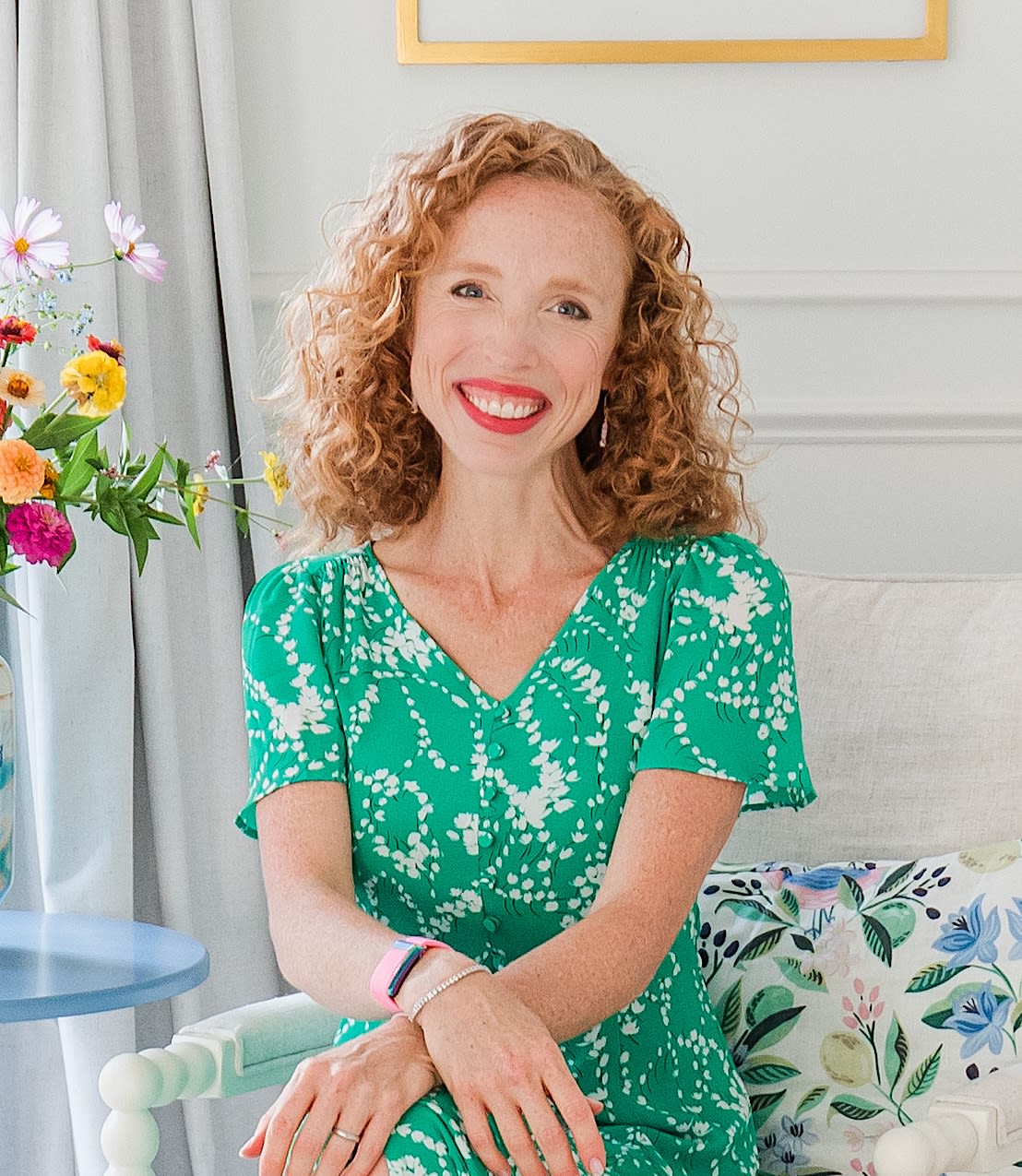
Paragraph
After founding Southern Weddings and Cultivate What Matters—and creating the beloved PowerSheets®—Lara Casey Isaacson found herself at two unexpected crossroads. In this episode, Lara opens up about what it looked like to walk away from the businesses she built, the restlessness that signaled it was time, and how faith, chronic illness, and family shaped her decision-making.
We talk about what it means to steward a season well, the quiet bravery of closing a chapter before the next one is clear, and how redefining success starts with letting go. If you’ve ever felt pulled in a new direction—or wondered whether it’s time to step away from something good—this conversation will feel like a gentle permission slip.
In this interview:
- [00:00]: Introduction and Intentionality in Life
- [02:58]: Career Journey and Transformation
- [06:11]: The Evolution of Southern Weddings
- [09:00]: Navigating Business Transitions
- [12:00]: Lessons Learned in Entrepreneurship
- [28:06]: Navigating Heartache and Identity Change
- [32:08]: Lessons Learned in Business and Money Management
- [39:14]: Finding Harmony in Work and Life
- [44:15]: Reflections on Growth and Relationships
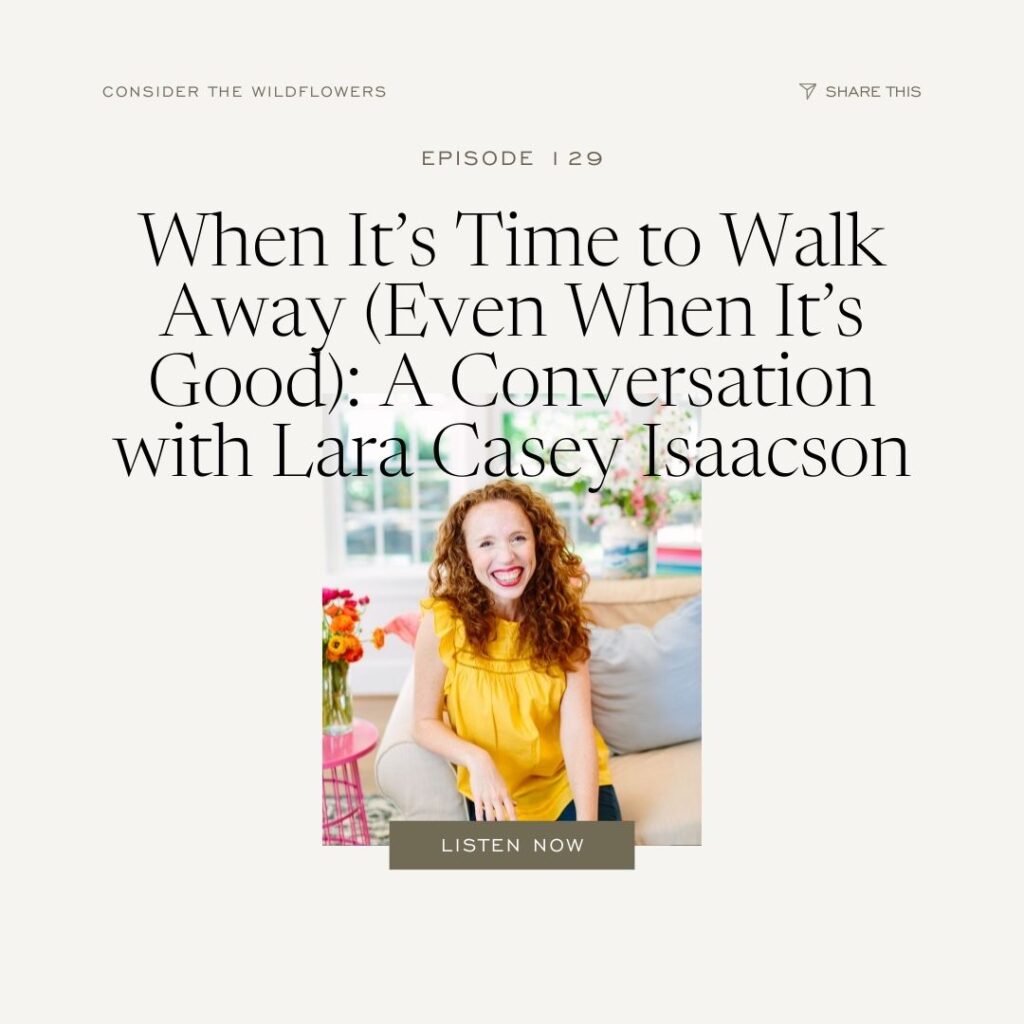
A Heartfelt Conversation with Lara Casey Isaacson on Intentional Living and Life Transitions
I mentioned this to you before we got on, and I want to say it again so that all the people can hear this—your story and your intentionality with your life and your time has directly intersected with my life and has made a big difference, even just in this current season I’m in. So I am—yeah, excited is an understatement. I’m just really grateful to be here with you.
Well, it’s been a long journey for me through my career. I actually, yesterday, went down an intentional rabbit hole of clearing out some file drives and found so many old photos from what I’m going to call the first half of my life—which is my career of building my first business in Southern Weddings and Cultivate What Matters—and really just trying to find myself at the same time, becoming a mom, et cetera, et cetera. Very much an online life, and I’m so thankful for so much of that.
And I remember distinctly when you made the decision to use your life in a different way—not share it with the social world, but really just dig in and trust and focus in on the people right in front of you. At the time, how radical that was, of course—but it just really got me thinking. I felt like a pretty intentional person, but what were my motivations for being where I was, in the spaces where I was? And were they fruitful?
You’ve made this point many times before too—it’s not that being online is good or bad. I really had to ask myself the question: where am I right now, and are these things fruitful or not? And the answer to a lot of it was no. So, yeah. It’s a different season for me.
We are in so many ways kindred spirits. I know—as you’re saying that, I’m thinking back to just the history and so many things that we’ve done along the years. And praise the Lord for all that-that it’s led us now to this conversation today.
Lara Casey Isaacson on Embracing a New Season and the Power of Small Steps
Yeah, so right now I’m in a season—I don’t want to use the word transition because it has a connotation that there’s something specific I’m heading toward—but it’s a season I’m calling my no-projects year. And there’s a lot I could say about that.
For the last two-ish years, since I sold Cultivate What Matters—and in the same breath, my father passed away—I’ve been on a journey of transformation, for sure. It’s led me to try a lot of different things, to use my gifts in different ways, and just to ask, “Lord, what do you want from me in this next phase of life?”
So to answer your question: I’m the CEO of my laundry room. I do business consulting for friends. I’m part of Faith-Driven Entrepreneur, where we’re building resources for teens to help them discern and discover their call to create. But all of that fits within five to ten hours a week, because the other 90% of my life right now has to be with my children—for so many reasons.
I’m a special needs parent. Our marriage is important to me. We homeschool. So, yeah, I really relish—and I don’t say this facetiously—I truly relish being the CEO of my laundry room. I love it, because I’ve had a long and busy career.
And it’s not to say that my career has ended and now this is what I’m doing forever, but I’m really grateful for this moment, for this season. That’s what I’m doing now.
Behind the transformation
To give you a brief background on what’s led me here—there’s always been a through line in my life of being fascinated by transformation. Much like you, I’m fascinated by what makes someone wake up one day and decide to think differently, act differently, work differently, interact differently with people. What precipitates that?
In the first half of my life, I always thought it was big changes or big movements that sparked that. But what I learned through founding Cultivate What Matters—and through helping coach women to see what matters in their lives and do something about it—is that it’s the little things that add up over the course of a lifetime. Not the big, sweeping gestures, but the small, faithful steps. That’s what leads to a life of love and legacy.
I’ve started several companies along the way. I began with wedding planning. I have a degree in music and theater, which led me to be a personal trainer in New York City, then to starting a wedding magazine, doing consulting, touring and speaking, leading the Making Things Happen Conference for 10 years, and founding Cultivate What Matters.
And while that may seem like a lot of jumps, there’s always been a clear thread running through it.
Lara Casey Isaacson on Childhood Wonder, Transformation, and Entrepreneurial Roots
When I was my kids’ age—right now I have an 8-year-old, a 9-year-old, and a 13-year-old—we lived in Washington, D.C., and there was an independent bookstore there called The Cheshire Cat. In the spring, they would have monarch caterpillars in the window, and we would go and just marvel at them as kids. We’d just watch and watch.
It almost seemed like nothing was happening when they were in their chrysalis. I’d walk by and say, “Mommy, nothing’s happening.” Then we’d go in and read Cinderella. And then—it was almost like, all of a sudden—they were ready to fly. They would burst forth.
And that’s really how I’ve felt about all the work I’ve been able to do, and the things I’ve learned through creating companies and helping people cultivate what matters. Sometimes you can’t see or feel the growth on the surface, but it’s those little-by-little choices we make on a daily basis that lead us to a point where we can burst forth and fly in a new direction.
I think, underneath it all, I did know I wanted to be an entrepreneur. I remember being very enterprising as a young person—we did lemonade stands, we thought up ways to sell things, or how we could create a business. It was all just pretend play in my house, but the mindset was there.
But I also moved into what I thought was going to be my lifelong career: music and theater. I loved learning what motivates a person. I loved exploring a character’s objectives and what makes them transform within a story. So, it really started very early on for me.
On Early Career Moves, Wedding Planning Roots, and Learning the Hard Way
Originally, I was doing personal training at the same time I was doing wedding planning, and the wedding planning—what I really would call wedding production—flowed very naturally out of my theater training. It used things like light, sound, music, and a menu to tell someone’s story, much like theater does. So that felt very seamless to me.
Also, my mother is a French chef, so I grew up surrounded by entertaining. She would host these amazing dinner parties where people just connected. I think that love of creating meaningful experiences was just in my blood.
So you’re a finance person? The answer is—I had no idea what I was doing. Zero clue.
I was in debt in the beginning. I would put things on credit cards. There was no internet back then—not really. It wasn’t until I started Southern Weddings that “blogger” even became a thing. So there wasn’t a real path for learning about personal finance unless your parents taught you how to balance a checkbook—which, believe it or not, was rare. I didn’t learn that. And the other option was going to school for finance. So there’s your answer—I had no idea what I was doing.
This was around 2003. I graduated from college in 2002.
As far as the transitions go—did I have a plan for all of that? No. I was really just following what fired me up, but also doing the things I needed for myself.
I needed a health transformation after college. I was so tired after such intense training at Carnegie Mellon University in music and theater—56 credit hours a semester. It was insane. And then I moved to New York City and was kind of thrown out to the wolves. I’m a very sensitive person, and I just didn’t love auditioning for my life. It felt like a lot of dissonance.
So I needed a space where I could feel alive in my body, without it being something I was constantly performing or presenting to people. That’s when I joined a gym and hired a personal trainer. As he helped me transform, I started to think, Wow, this is something I feel really passionate about. I could help people with this.
Lara Casey Isaacson on Staring Southern Weddings and the Overlapping Seasons That Shaped Her Path
Southern Weddings began in 2007. My husband was deployed to Iraq, and I was very restless. I needed a project—something to keep my mind off bomb threats. So, I started thinking back on all my wedding planning experiences and the beautiful things we were able to create in my tiny little small town.
I thought, There’s so much more we can share with people about how to tell their love stories—beyond just chicken and tulle. There’s a transformative possibility here, much like when you go to a really great theater show or movie—you leave changed, with new thoughts and ideas. I saw that potential in wedding planning too.
Yes, during that time, the timelines really do overlap a lot—and they still kind of do. I was working as a personal trainer, and fun fact: as of December 2024, I’m once again a certified personal trainer. It feels good—like coming full circle. That love has always been there for me: helping people understand their motivations and do what really matters in life.
To try to map out the timeline—if I remember correctly, since this was 20-something years ago—I graduated from Carnegie Mellon, moved to New York City, and ordered snail mail materials to start a personal training course. This was after going to the gym a few times and realizing the impact it could have on people.
At the same time, I was wrestling with this feeling of after everything my parents and I have poured into this… is theater really the thing for me? I loved performing and the art of it, but I didn’t love the business side.
From Personal Training to Planning: The Unexpected Path to Weddings
So while I was getting my personal training certification and working with clients, one of those clients happened to be a wedding planner. Around the same time, my mom and I were talking—since it was looking like theater might not be my path—and she suggested, “Why don’t we do events together?” That had always been her dream too. She went to Le Cordon Bleu in Paris and had long had a vision for a new chapter after raising kids.
So, a lot was converging. I ended up marrying another trainer I met at the gym—for a very short, very difficult time. That’s a whole other story. But through that season, I really caught the bug for floral design and wedding planning.
That was the 2002–2004 window. Then through 2004, 2005, and 2006—before Ari and I got married—I continued growing my wedding planning business and doing some training on the side. Those years were very much about exploring and holding space for both paths.
The Birth of Southern Weddings
Then we come up to the launch of Southern Weddings, which was a whole new world. It took up a huge amount of my time. I eventually stopped doing personal training and shifted fully into the wedding world.
It took off like a freight train in Georgia—I had no idea how quickly or how significantly it would grow. The magazine took off. Wedding planning continued for a little while, but eventually had to phase out as the magazine demanded more of me.
Lara Casey Isaacson on Seasons of Work and Knowing When to Move On
To speak a little bit to what you said about being multi-passionate—I think that’s where the work I’m doing now with Faith-Driven Entrepreneur really comes in. College is a really expensive place to try to figure out what you want to do with your life. Back when I was starting out, there just weren’t a lot of resources for someone like me—a multi-passionate person. And honestly, I think most people are. There are so many gifts in us that either haven’t been unlocked yet or we don’t know what to do with them, or we’re not even sure what they are.
Today, there are a lot more resources to help with discernment and figuring out your calling as you move through different phases of life. But for me, I kind of did it in reverse—I started doing that work after college.
I think a lot of us did. It was really a generational thing. In my generation, you chose a career and you stuck with it. But I got out of college and knew that wasn’t going to work for me.
So fast forward about ten years into Southern Weddings, which had really become an iconic brand by that point. We had a partnership with Southern Living, things were going really well. It was a small team, but we were profitable. Everything looked great on the surface.
But we had, somewhat accidentally—though I’d say accidentally on purpose—started a shop. Since our model was just a once-a-year print edition, and not monthly issues like traditional magazines, we needed a way to stay connected to our audience more consistently. So we thought, What if we put out a print? This was unheard of at the time. There really weren’t any online shops outside of maybe Amazon. But small independent product shops? Basically nonexistent.
So we launched a single print that said Love Never Fails. And it just snowballed from there. People wanted tangible reminders of what mattered on their walls. So we created a few more prints. Then it kept growing—and eventually became the Lara Casey Shop. I was sharing prints with inspirational messages I had written. We launched the first PowerSheets goal planner, which still exists today and is still growing.
The Turning Point: From Southern Weddings to Cultivate What Matters
So now we had two things growing at once: what became Cultivate What Matters and Southern Weddings. Both had specific and meaningful missions. But by 2016, I started to feel really restless. I felt strongly called to homeschool my daughter. I didn’t want to go through the process of trying to find a buyer for Southern Weddings, because I didn’t think anyone could carry the mission forward the way we did.
At the same time, Cultivate What Matters had incredible growth potential—far beyond just the wedding or newlywed season of life. It could serve people in every stage of life.
I had a lot of trusted advisors saying, “Lara, I know this thing means a lot to you, but you’re crazy—how could you let it go?” Others are saying, “You’re crazy not to pursue the growth potential with Cultivate What Matters.”
So how did I know? Honestly—restlessness. I didn’t have full clarity. I’ve learned sometimes you have to let go of one thing before you even know exactly what the next step is.
Yes, we had wise counsel. We had accountants and business mentors helping guide the process. But in my heart of hearts, it was still really difficult to lay it down.
Lara Casey Isaacson on Letting Go of Cultivate What Matters and Trusting the Unknown
It was similar in the sense that there was definitely restlessness—I knew something needed to change. But it was also different. That season stemmed from a combination of things. My father’s health was declining. My own health was declining. I was showing up to work every day in chronic pain, and after six years of that, I just felt—this is my own perception, no one told me this directly—but I truly felt like God was saying:
This needs to grow, and you need to get out of the way.
It was as if I was being called to put it into the hands of someone else who could take it and run with it. Because what I really needed to focus on was my family. And that would mean letting a piece of my ego fall off. It meant facing a lot of unknowns. It was humbling. I had no idea what the future held—I just knew I couldn’t keep going at the pace I was moving.
What went well? Always, always—people.
Even now, I get chills and a lump in my throat talking about it. I’ve been so blessed to work alongside incredible women. Letting go of those daily working relationships was the hardest part, but praise God, those relationships haven’t just stayed strong—they’ve deepened.
And then there were all the people we connected with through both brands—Southern Weddings and Cultivate What Matters. Brides, mothers of the bride, couples, and later, people all over the world through Cultivate. So many of those relationships continue today. Despite my own shortcomings, and despite many mistakes I made along the way, what went well was God’s faithfulness in and through those connections.
We used to call it the profit of people, and we prioritized that over everything. We even sent out every issue of Southern Weddings with a handwritten thank-you note. It didn’t matter if we had 10,000 issues—we would still find a way to sign those notes. Because that mattered.
Another thing that went well? Growing things that last. In the end, I came to understand that we weren’t closing Southern Weddings—we had simply completed the work we were given to do. That shift in perspective felt really good.
And finally, enthusiasm. If I could give anything to people, it’s that. Our motto through all those years was: If you’re not excited about it, no one else will be either. Enthusiasm, at its root, comes from the Greek word entheos, meaning from God. So when you start from a deep (and imperfect) connection with God, and live out of that, it produces the kind of work people want to be a part of.
What didn’t go well? All the times I tried to rely on myself instead of God.
There were many of those moments—and they came at the expense of my health. I praise God that I’m no longer suffering from chronic pain, but back then, I often put my work above my well-being. The work was meaningful, and Scripture is clear that we are to expend ourselves on behalf of others—we’re not meant to reach the end of our lives saying, Wow, I was so comfortable.
So I don’t regret giving my all, but I do think there were healthier ways I could have gone about it. That was a difficult lesson.
Lara Casey Isaacson on Learning the Hard Way and the Value of Smart Surroundings
I think another thing I’ve learned is the importance of surrounding yourself with people who are smarter than you. Therefore, I was very grateful I got to do that. I knew I wasn’t going to have all the answers over all those years—and I didn’t.
Working alongside a team that was always smarter than me led to productive and profitable work. I learned that the moment you stop learning, you’re done.
Another thing I’d say—something that didn’t go well—is I wish I had pursued a degree in business or finance before starting all of this. That really speaks to your heart for meaningful, grounded finances. I had to learn everything on the job.
Now, I do feel confident in that area, but I struggled for years just trying to understand a cash flow statement, figure out margins, and ask what felt like dumb questions. I think I could’ve saved myself a lot of heartache and confusion if I’d had more training in that from the start.
Lara Casey Isaacson on Letting Go, Grief, and the Transformation of Identity
Yeah. So, it’s hard to let go of a dream. It’s hard to let go of something you’ve poured your heart and soul into. And, it’s still hard for me. There are days I text Emily Thomas, my former coworker, and say, I miss Cultivate. Or I’ll pick up a photo or see something in my office and think, I miss that moment.
Those are the times that invite me into the holy, gruesome, and beautiful experience of grief.
So how do you do it? You do it in the same way you grieve anything. I learned this through being the sole person there to hold my dad’s hand as he crossed over to be with the Lord.
There is a sting in death—and it’s very real. I remember him wincing. He was in such pain for just a moment—a mere second—and then there was peace.
I come back to that often. Whether it’s the loss of a loved one—like losing my father or my best friend suddenly to cancer last year—or whether it’s intentionally and purposefully letting go of a dream or a business… the process is similar. Sometimes you don’t even need to let go of the business entirely. Often, it’s about letting go of how you’re doing it. The model, the method, the pace.
That restlessness is an invitation. So is the pain. Rather than pushing it away or piling on judgment—you shouldn’t feel this way, you should be working harder—I try to ask, What can I learn from this? I try to talk to myself compassionately instead of critically.
That, for me, always opens the door to growth, wisdom, and clarity.
Lara Casey Isaacson on Money, Stewardship, and Learning Financial Wisdom the Hard Way
Fundamentally, the best thing I’ve learned about money is this: it’s not ours. We’re given it to steward.
That might sound like Christianese, but it’s real. It’s truly not ours—we’ve been entrusted with it to do good things. I think about money like seeds. Every dollar I spend is a vote for something. It’s like planting a seed for someone’s future—or for my future self.
It’s also a map to our psychology. I’m learning this even more in my current season—the things I feel compelled to spend money on, or the things I reflect back on having spent money on, they reveal something about where I am emotionally or mentally. And in business, the same thing applies. The decisions we made—or didn’t make—about spending money reflected where we were, what we believed, and how much risk we were willing to take.
Two real-life examples
First, there was a season when Cultivate What Matters was in a major growth mode. Things were going really well—this was back before Facebook ads got expensive. You could spend $20 and make $2,000. It was kind of a golden age.
At one point, we thought about making a big move. We considered taking most of our cash on hand and investing it into a huge print run of one of our core products—Write the Word journals—based on our projected growth. But that would’ve put us in a serious cash flow crunch.
Psychologically and emotionally, we wanted to go for it. We believed in the impact. We saw the seeds of faith that those products could plant in people. But I had to stop and ask: Why grow this fast? Why not affect the same number of people, just more slowly, and do it in a way that was wise and sustainable?
And I’m so grateful we made that call. Because shortly after, several market factors changed—technical things—and looking back, we realized how much God protected us by not taking that leap.
Second, when I was in the process of letting go of Southern Weddings, I learned another big lesson about cash flow.
All the cash flow for Southern Weddings came in right before the annual issue launched, so around October. But with Cultivate What Matters, we had to pay for PowerSheets inventory early—sometimes as early as February or March, and even as late as December when shipments landed.
So when we removed the Southern Weddings cash from our equation, we were suddenly in a massive cash flow crunch. And we didn’t see it coming.
That was a big wake-up call. Understanding cash flow—timing, payment cycles, planning—was a huge lesson for me. And one I’ll never forget.
Lara Casey Isaacson on Scaling Cultivate, Managing Risk, and Building a Trusted Team
Yeah. Those are scary numbers.
I think at this point, because the business is no longer in my hands, I would be open to sharing actual numbers—but out of respect, I don’t think I can give specifics. What I can say is that we were reaching tens of thousands of people. In terms of scale, this was a business that started in my garage and grew into something that required a full-scale third-party logistics (3PL) warehouse operation.
It became far more than I ever imagined—and far more than I personally knew how to manage.
I remember a dear friend and former team member telling me that once you reach the $3 million range in e-commerce, that’s when things start to get “crunchy.” That’s when your systems have to evolve, your financial oversight has to level up, and your operational capacity has to expand. And it was true.
When we crossed that threshold, I had to bring in a financial strategist—someone who not only understood accounting, but could help us with decision-making, projections, and strategic growth. I already had accountants, of course, but what we needed at that point was someone who could think big-picture with us.
We also needed strong operations support. And to be clear—our team was still small. There were about eight of us consistently. But we were running a full-scale product business. Having someone on board who could manage sourcing, ordering, and production at that level was absolutely essential.
It wasn’t something I could figure out alone. I had to learn to ask for help—and surround myself with people who knew what I didn’t.
Lara Casey Isaacson on Leadership, Growth, and Choosing the Speed of Relationship
But really, I have to say: none of this happened overnight. How do you do it? It sounds overwhelming to talk about it now—and honestly, it is overwhelming to talk about it in this context—but in reality, it happened one relationship at a time, one person at a time. That’s the way I wanted it to happen.
It all grew at the speed of relationship. And if it had grown any faster than that—sure, there are things we could have done to make more money. Many things. But pulling those levers would have come at the expense of people.
And for me, that was never worth it.
Lara Casey Isaacson on Life-Work Harmony and Knowing What to Prune
Yeah—you can’t do it all and do it well. You just can’t.
At this stage, as I do business consulting with a lot of people who are in what I call “stretchy spots”—the moments when you’re asking, Do I sell my business? Do I take on investors? Do I scale or pause?—I see so many people pushing beyond their limits. And while I don’t love the buzzword “burnout,” it’s real. It happens. A lot.
So how do you find harmony in work and life?
You have to cut something to make room for something else. That’s just the truth. In my journey, God has allowed me to be part of growing a number of things—amazing things—with incredible teams. But as they grow, if your trellis isn’t strong enough to support them, you have to prune.
I always go back to my garden. I think about my tomato plants. They can look huge and lush—so many leaves, so much growth. But unless I start cutting things back, the nutrients can’t reach the actual fruit. The plant looks busy and alive, but it’s not fruitful.
It’s the same with our lives and our work. We have to be honest about our capacity. We have to prune in order to bear good fruit.
And I’m going to step on a little podium for a second here—I don’t like when I hear the message that we can “do it all.” That narrative is so pervasive, especially for women. But we have to push back on that. You can do many things over time, but not all at once and not without cost.
Lara Casey Isaacson on Humility, Seasons, and What Really Matters
When I hear younger people—and I don’t mean by age, I just mean people who are new to business—say things like, You can do it all, you can have it all, I think… maybe in little pieces. But if we’re talking about living a life that’s deeply connected—motherhood, meaningful work, keeping your laundry done, taking care of your health—there are only so many hours in a day. You have to choose.
And honestly? That takes a ton of humility. That’s been the hardest part for me over the last two years. Because I do have a lot of skills I could use. There’s a lot I could do. But I keep asking myself: What is really going to matter at the end of my days?
Right now, I have five years left with all three of my children under one roof. My oldest is 13. I’ve got five years—maybe—left with her at home. I remind myself of that often: This is all I’ve got. I know I’ll never regret choosing to be present in this season instead of starting something new and big.
Choosing What Matters (and Hot Pink Earplugs)
I just want to soak that in. I think there’s so much messaging out there right now. So, I feel really blessed that I started my business back in the Blackberry days—before Facebook, before Instagram. I’ve been in business almost 20 years now in the finance world.
And I think back then, we didn’t have the same messaging around hustle or doing it all. Now there’s so much pressure to be a stay-at-home mom and run a business. And yes, you can do both—but not at the same time, not without trade-offs.
Like you said: You can’t do it all—and you definitely can’t do it all at the same time.
Quick Fire Round With Lara Casey Isaacson
What’s one thing you’d be embarrassed if people knew?
I’m kind of an old lady—and I’m not super embarrassed about it, but it’s a little awkward when I have to explain it! So this qualifies: I like to go to bed at 7. I wake up at 5. I often work out in my bathrobe. And I wear hot pink earplugs to bed.
I’ve fully embraced my old-lady-ness—and honestly, I love it.
Any regrets or wish you could do over moments?
Okay, this one hits me hard, to be honest. And sorry, it’s not super rapid fire!
But yes. When I look at the entirety of my career—20 years—I see so much growth. And if I could go back and do all of those years the way I’ve done the last few, I would. I’d love to go back and balance things more meaningfully. I’d love to bring the perspective I have now into those earlier seasons.
Oh, it’s wonderful. I’m so thankful for that. Now I do know—and I trust that I’ll continue to grow, God willing. As He continues to shape me, I know I’ll look back again in five years and say, Wow, I can’t believe I thought that—or said that! And I’ll be grateful for the wisdom He’s given me in that future moment too.
He’s never done with us.
Any Big Wins or Pinch-Me Moments?
I think one of the biggest “pinch me” moments was the partnership we had with Southern Living. I remember sitting around the table with all the editors in their Birmingham office. Emily and I just looked at each other like, How did we get here? This is so cool.
It was July, and they were already preparing for their Thanksgiving issue. I remember walking past the test kitchen and seeing a full Thanksgiving turkey being tested—and just thinking, This is the coolest moment. It felt surreal.
What is The Best Advice You Have Ever Received?
Oh my goodness… I think the best advice I ever received was through the life of my grandfather.
When you met him—seriously—the first thing he’d say if you showed up at his door was, “Hey, it’s great to meet you! Let me show you something.” And then he’d go get a picture of his beloved wife, Lust, and bring it to you. He was completely enamored with her.
He loved his marriage deeply. And he would bring her wildflowers in the morning—which, of course, makes me think of your podcast.
And so, the best lesson I learned wasn’t something he said—it was something he lived. It was his unwavering dedication to relationship. That’s the best advice I’ve ever received.
And I pray for that same kind of connection in my own marriage.
What Are You Working on Now, or What is One Resource You Would Like to Share?
I’m trying to get my first post on Substack out—so I’m working on that! I’m also working on a small book, and I’m continuing my work with Faith-Driven Entrepreneur.
One of the most exciting projects I’m part of is a new podcast for parents. It’s focused on helping teens and preteens begin the process of discerning their calling—figuring out what God made them to do, and opening their eyes to the possibilities of living with purpose inside the Kingdom.
Back when I was a kid, if you wanted a job that had anything to do with God, you’d go into ministry or become a pastor. Now, there are endless ways to live that out and build redemptive businesses. So I’m really excited about helping families and young people explore that.
Looking Back: Lara Casey Isaacson’s Message to Her Younger Self
I would tell myself: You are so loved.
That really speaks to how incredibly insecure and lost and broken I felt at the time. Starting a business—especially starting Southern Weddings—came out of fear. Ari and I were, at the time, just two ships passing in the night. We didn’t have a strong foundation of faith. I was looking for something to hold onto.
It took years to learn that my work is not my worth. But if I could go back and say anything to that younger version of myself, it would simply be: You are so loved.
Lara Casey Isaacson
 Lara Casey Isaacson is an accomplished entrepreneur, author, and speaker.
Lara Casey Isaacson is an accomplished entrepreneur, author, and speaker.
As founder of Cultivate What Matters, Lara created the popular PowerSheets® Intentional Goal Planner, the Write the Word® Bible journals, and led the Making Things Happen Conference for over ten years and 55+ conferences. Lara founded Southern Weddings magazine and enjoyed partnerships with Southern Living and TIME, Inc.
Lara’s experience in faith-driven leadership and goal coaching led her to author three bestselling books: Make it Happen, Cultivate, and Gracie’s Garden.
She loves hiking, cooking, Charlotte Mason homeschooling with her children, digging into functional medicine and fitness with her husband, Ari, and getting her hands dirty in the garden in Chapel Hill, NC.
CONNECT WITH LARA CASEY ISAACSON:
Website | Substack | Instagram
May 22, 2025
Previous Post:
Next Post:

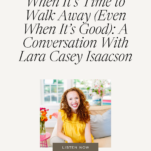
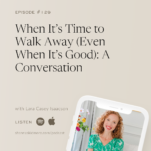

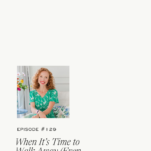


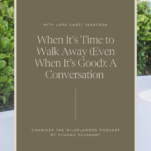
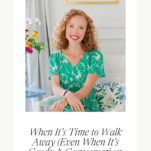

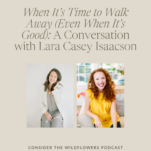
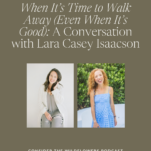
And if you found this helpful, share with your friends!